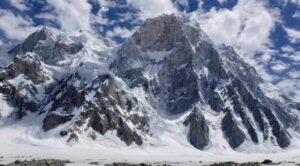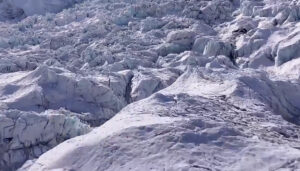The autumn of 1990 broke all previous records for the number of climbers attempting Himalayan mountains. Seventy-eight expeditions of 553 foreign climbers, accompanied by 217 Sherpas, flocked to the base camps.
On Everest alone, there were 12 different expeditions that season. Until then, from Hillary and Tenzing’s success till then, 325 people had climbed Everest, including 43 without bottled oxygen.

Pasang Lhamu Sherpa, the first Nepali woman on the summit of Mont Blanc earlier in 1990. Photo: Pasang Lhamu Sherpa Family
A Nepali female climber appears
The first woman to summit the highest mountain on Earth was Japan’s Junko Tabei, on May 16, 1975, with supplemental O2. The first woman to climb it without O2 was 27-year-old New Zealander Lydia Bradey, on October 14, 1988. But in the early 1990s, no Nepali woman had reached the top with or without O2.
Then in 1990, 28-year-old Pasang Lhamu Sherpa showed up. She wanted to be the first Nepali woman to reach the top of the world.

Pasang Lhamu Sherpa on her first Everest attempt in 1990. Photo: Pascal Tournaire
Escape from the old rules of the society
Pasang Lhamu, a daughter of mountaineers and already a mother of three children, had begun her adventures in childhood. Her three brothers went to school, but Pasang never received a formal education. At the age of 17, she left her native village and escaped to Kathmandu with her chosen love, Lhakpa Sonam Sherpa, so that she would not have to marry another man through an arranged marriage. With Lhakpa Sonam, she founded her own agency, Thamserku Trekking.
Pasang Lhamu had climbed Pisang Peak (6,091m) in Nepal. Earlier in 1990, she became the first Nepali woman to summit Mont Blanc. However, she had no experience on 8,000’ers.
The first attempt and the controversy
Through her agency, she met French mountaineer Marc Batard, who invited Pasang Lhamu on his autumn 1990 Everest expedition. At that time, Batard still held the speed record for a no-O2 ascent of Everest. In the fall of 1988, he summited in 22 hours and 29 minutes.
. This time, Batard’s goal was to climb Everest and Lhotse on the same day.

French alpinist Marc Batard. Photo: Marc Batard
Ordered to turn around
Batard had a large team of 21 climbers, including several women. During the first summit push in late September, Batard realized that Pasang Lhamu climbed too slowly, so ascending beyond the South Col would be too risky for her. Climbers from other teams also thought that Pasang Lhamu was not strong enough to summit that day. As the leader of the expedition, Batard asked Pasang Lhamu to abort her attempt at 8,000m.
Pasang Lhamu stormed off the mountain. Batard offered her a second summit push, but she declined. Pasang Lhamu returned to Kathmandu, where her husband filed a formal complaint at the Ministry of Tourism, saying that a foreigner had not allowed a Nepali woman to climb a Nepali mountain. The scandal drew attention.
On October 5, 1990, several climbers reached the summit, including Christine Janine, who became the first French woman to climb Everest. Batard also reached the summit but gave up his plan to climb Lhotse as well, because of mild frostbite.

Everest from the Gokyo Valley. Photo: Shutterstock
Batard’s troubles
In spring 1991, Marc Batard returned to Everest to repeat his Everest-Lhotse doubleheader attempt. According to Batard, when he arrived in Kathmandu, an official from the Ministry of Tourism told him that the permit was being issued and that he would receive it presently. Batard, therefore, moved to the mountains.
On May 1, Batard reached 8,200m, but strong winds forced him to abort that push and descend to Base Camp to rest. There, he discovered that they did not grant him the permit after all. For having tried to climb the mountain without one, he could be banned from Nepal for years.
Batard left very disappointedly, and although he had plans to return to Nepal that fall, he said, “I have been very badly victimized in Nepal this time by those making charges and withholding my permit. I have decided to cancel all my future climbing activities in Nepal.”

Alberto Inurrategui on Everest in 2006. Photo: Alberto Inurrategui
New attempts by Pasang Lhamu
In the fall of 1991, 12 teams again showed up on Everest, including the one organized by Pasang Lhamu and her husband. It included 16 climbers, most of them Nepalis, plus four French and one Belgian. The leader of the expedition was Pasang Lhamu, although her husband and another Sherpa performed most of the leadership duties.
Some climbers from other teams said that at Base Camp, Pasang Lhamu’s husband told them that his wife should have priority among all climbers going to the top. This also raised controversy between her and foreign climbers.

Pasang Lhamu Sherpa. Photo: Thamserku
On September 30, 1991, during her first summit push, Pasang Lhamu and several members of her team reached 8,748m. Then the wind grew stronger and they were unable to climb further. The Europeans started their summit push on October 4, 1991.
Among them was Chantal Mauduit. They also could not summit because of strong winds. Mauduit and Belgian Karl Huyberechts considered making a push, but this would have violated Pasang’s husband’s order that foreign climbers could not proceed ahead of his wife. In the end, however, strong winds prevented Pasang Lhamu from climbing further. On her next summit push, she couldn’t get beyond the last camp at 7,900m.

Pasang Lhamu Sherpa in 1990. Photo: Pascal Tournaire
Obsession
Some climbers, including a Nepali guide, recalled that Pasang Lhamu “used to walk five minutes and rest for fifteen minutes”. They also said that she was not good at using crampons while descending. She usually had to go down sideways.
However, Pasang Lhamu did not give up. By now, other Nepali women had the idea to summit Everest, as well as several Indian female climbers. Pasang Lhamu’s determination evolved into an obsession after her three attempts. Perhaps, in part, it was because the media focused on her, and Nepal needed a national heroine.
“I am determined to climb Sagarmatha on behalf of Nepali women without caring for my life,” she said. “I am determined to concentrate more on the promotion of national identity on behalf of Nepali women, who are no less courageous than men.”

An almost invisible line of climbers heads up the Southeast Ridge of Everest. Photo: Pinterest
Spring 1993
In 1993, the Indians urged Nepal to give climbing permits to Indian women to commemorate Tenzing Norgay and the first ascent of Everest. In return, the Indians would include two Nepali climbers on the team. According to Elisabeth Hawley’s 1994 report, Pasang Lhamu, who had already had three Everest attempts, felt entitled to co-leadership. However, the Indians declined to accept her onto the team on those terms.
According to another version, Pasang Lhamu wanted to join the Indian team, but Nepal’s Ministry of Tourism selected two other Nepali women — Nimi Sherpa, who previously climbed Makalu and Nuptse, and Upsana Malla, a trekking and mountaineering guide. According to this report, Pasang Lhamu had been sidelined.

A climber steps across a ladder in the Khumbu Icefall. Photo: Andy Bardon
According to Indian climber Rita Gombu Marwah, a member of that Indian team, Pasang Lhamu was not selected because she had a rivalry with Nimi Sherpa, who also intended to become the first Nepali woman to summit Everest.
Pasang Lhamu and her husband Lhakpa Sonam Sherpa quickly organized an independent team, the Nepali Woman’s Everest Expedition, under the leadership of Pasang Lhamu. It arrived in Base Camp on March 30, 1993. They also had a sponsor, San Miguel Beer, that paid half their fees. In the team of 10 climbers, there were two other women, Lhakpa Futi Sherpa and Nanda Rai, plus seven Nepali men.

Everest Base Camp, 2021. Photo: Kenton Cool
The decisive climb
Finally, on April 21, 1993, Pasang Lhamu and some of her teammates reached Camp 4 (7,900m). Lhakpa Futi and Nanda Rai were unable to attempt the summit, for different reasons. One of the team members, Sonam Tshering Sherpa, who had previously climbed Everest four times, had suggested before the summit push that they should set up an extra camp at 8,500m, but his idea was ignored. They didn’t want to waste time. That night the weather was still fine, and Pasang Lhamu, along with five Nepali men, began the final push at midnight.

The Khumbu Icefall on Everest, with Lhotse in the background. Photo: Jon Griffith
They were determined to get to the top before the Indian women. The climbers did not want to communicate with anyone or let others hear what they were talking about, so they left their walkie-talkies behind. They did not carry sleeping bags or bivouac equipment, because each man was already carrying 26kg loads of oxygen bottles for themselves and for Pasang Lhamu. She carried only one bottle for herself. There was no other team on the South Col. In an emergency, they couldn’t count on anyone’s help.
Summit
Pasang Lhamu and Sonam Tshering were very slow during the ascent. Sonam Tshering was not feeling well. The final leg, which usually takes 10 hours, lasted 14.5 hours for the small team. Finally, Pasang Lhamu and five of her companions summited Everest on April 22, 1993, at 2:30 pm.
Trouble during the descent
The weather changed radically after the group summited. The group of exhausted climbers divided into two. The first group continued descending. Pasang Lhamu and Sonam Tshering stayed in the Death Zone, on the South Summit, and a third companion, Pemba Nuru, remained with the pair. They had to make an impromptu bivouac, and they ran out of O2.
The next morning, the situation was very ugly. Sonam Tshering’s condition worsened. Pasang Lhamu was also very ill and could not stand. Pasang Lhamu sent Pemba Nuru down to the South Col so that the first group that had already reached that point could bring oxygen up to them.
But their companions at the South Col were also so exhausted that they could not ascend back up again at that time. On April 24, the Sherpas tried to climb to Pasang Lhamu and Sonam Tshering, but the wind was so strong that they had to turn back.

Climbers in the Death Zone. Photo: Lhakpa Sherpa
Climbers from different groups were only able to reach them 18 days later. They only found the body of Pasang Lhamu. Sonam Tshiring had probably fallen. According to other climbers, Pasang Lhamu and her team had started the summit push too early.
The other problem, they said, was that Pasang Lhamu did not know how to descend the mountain well. She was also later criticized for putting her own success before the safety of her teammates, and for even competing with the other two women on her own team. Finally, with the help of foreign climbers, they managed to lower Pasang Lhamu’s body from 8,750m.
This was the highest rescue in history, which was much commented upon later because it morally forced future teams to attempt to lower the bodies of deceased climbers from such great heights. Previously, the custom had been to leave them where they lay.

Statue of Pasang Lhamu Sherpa in Kathmandu. Photo: Pascal Tournaire
Pasang Lhamu became a legend. Although rumors said that she really did not summit, the official version and Himalayan Database states that she did. After her body had been lowered from the mountain, she was the first woman to be decorated with the prestigious Nepal Tara by the King Of Nepal.
Jasamba Himal (7,315m) in the Mahalangur Range of the Himalaya was also renamed after her, becoming Pasang Lhamu Peak. A 117km road in Nepal now also bears her name.






